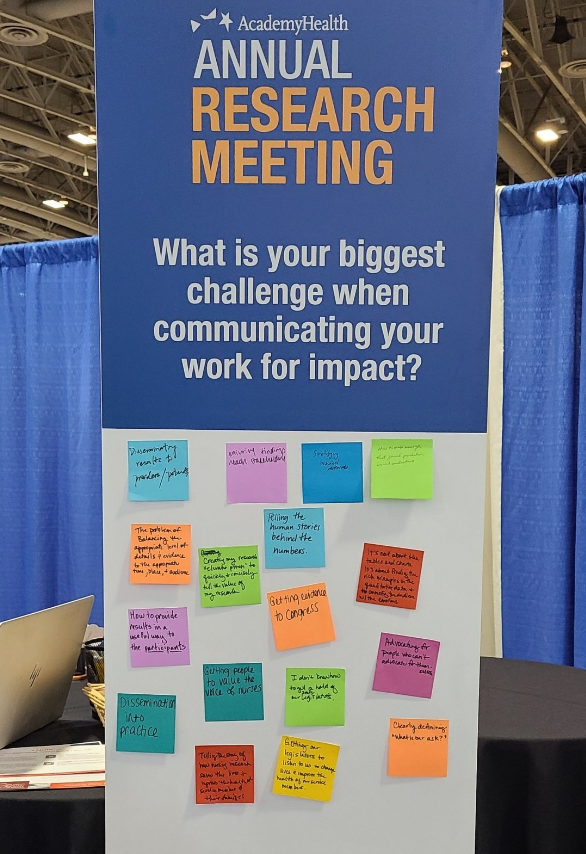
There’s nothing worse than producing a body of work only for it to go unseen – or perhaps even worse, completely misunderstood – by the community who could benefit from it the most.
Communicating and disseminating research to drive impact is one of the top professional challenges for health services and health policy researchers, as reported in a 2021 survey conducted by AcademyHealth. Researchers also reported their top professional goal is to build the visibility of their expertise and work.
In reviewing the results of the survey, we were fascinated to see how the top challenge and the goal were connected. By overcoming the key challenge of communicating research for impact, researchers can accomplish their top goal: getting their research the visibility and exposure it deserves.
Communicating for Impact: What Does it Really Mean?
“Communicating for impact” refers to one of the most important steps in the research lifecycle. After you’ve planned your study, implemented and collected your data, processed and analyzed it, it’s then time to share it. For research to be most valuable, it’s not enough to just produce it and let it sit on the shelf. It must be used, which of course requires that those who would use it, know about it, and understand it. This is where communicating for impact comes in.
Communicating for impact goes beyond publishing your results. It is when a researcher disseminates their evidence in a format and manner that motivates stakeholders and policymakers to take action. That action can take a variety of forms. For example, it might be that the research informs a policy change or that a health system implements a practice change based on the findings. Action could also occur on a smaller scale, a funder awards additional funding to a well-described grant proposal or a community organization decides to partner with you on a pilot intervention.
Communicated for Impact Ultimately Improves Health Care
AcademyHealth has long been committed to building the field’s impact and has honored particularly effective health services researchers through our Health Services Research Impact Award. Awardees’ work over the years have influenced pandemic-related policies in Indiana, changed the public policy conversation around population-based payment models, informed implementation of milestone legislation such as the Affordable Care Act, and prompted policy changes to improve psychological care for returning military personnel.
When you review these examples, they all include evidence of a strategic communications plan that reached the right people, with the right message, through the right channel and at the right time. This is communicating for impact in action and is clearly an essential competency for effective health services researchers.
Communicating for Impact Requires Going Beyond Journal Publication and Conference Presentations
Achieving this kind of impact often requires going beyond the mainstream channels of research dissemination such as publishing in peer reviewed journals or presenting at academic conferences. While these channels remain critically important, research shows that even academics only read about 200 of the 2 million peer-reviewed articles each year. You can imagine for busy, generalist policymakers and other end users of research, this number would be even lower.
Communicating in a way that sparks action among end users of research also requires researchers to speak and write differently than the way they are traditionally trained. For instance, the standard abstract structure is typically: hypothesis, methods, results, discussion/implications. For end users of research, it’s necessary to structure the message delivery differently to feature the implications up front.
Communicating complicated research findings to people outside your area of expertise brings a whole host of other challenges. For example, many studies have documented the fact that simply providing information is not enough to achieve understanding, let alone behavior change. As Aaron Caroll noted in a New York Times article on the subject: “Dropping knowledge from on high — which is still the modus operandi for most scientists — doesn’t work.”
Moving Beyond the Traditional Dissemination Model
Those who have mastered the skill of communicating for impact move beyond that typical modus operandi described by Carroll by developing a deep understanding of three key things:
- They know who their target audience is and what that audience cares about.
- They can craft effective messages that resonate with their target audience(s).
- And, they have identified the channels where their target audience is and ways to reach them (e.g.,. social media, blogging, traditional media).
To help researchers overcome this challenge, AcademyHealth developed a custom-tailored solution: the Communicating for Impact course. Designed for busy professionals, the course breaks down each step of the process to create a comprehensive communications plan, which can get your research into the hands of policymakers, key stakeholders, or whomever your target community may be.
The course provides useful templates and resources, to build your communications toolkit, including:
- An Audience Influencer Map to pinpoint exactly who your audience is (so you can determine how to best meet them where they are and reach them).
- A fun, interactive Messaging “Mad Lib” which gamifies the process of translating your technical data and research methods into compelling stories and effective messaging points.
- Downloadable Tools and Handouts to help you develop the appropriate collateral, which resonates with your target audience.
Bring your research to life and learn how to tell the rich stories underneath your data that will spark action and make an impact. Enroll in the Communicating for Impact course by August 31.